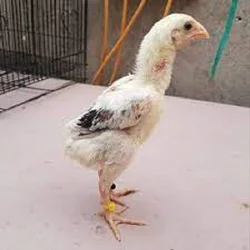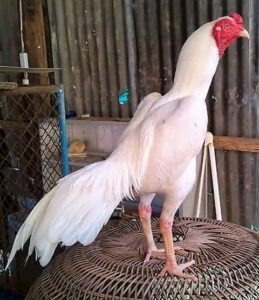Unraveling the Enigma of Asil (Aseel) Chickens
Welcome to our comprehensive guide on Asil (Aseel) chickens! These majestic birds have a rich history and distinctive characteristics that set them apart in the world of poultry. Join us as we explore everything you need to know about raising and caring for Asil (Aseel) chickens. Step back in time and delve into the fascinating history of Asil (Aseel) chickens. Originating in South Asia, these birds have a lineage that dates back centuries, where they were revered for their strength, courage, and fighting prowess. Discover how they became prized for their unique traits and resilience.
Egg-cellent Insights: Asil (Aseel) Eggs and Production
Size
These eggs are typically medium-sized.
Color
Asil (Aseel) eggs come in various shades ranging from light brown to tinted.
Production per year
Asil (Aseel) hens are poor to moderate layers, producing approximately 50 to 100 eggs per year.
When do Asil (Aseel) chickens start laying eggs?
They usually begin laying eggs around 7 to 8 months of age, heralding the start of their egg-laying journey.
Asil (Aseel) Chicken Breed Characteristics
Temperament Traits: Understanding Asil (Aseel) Chicken Behavior
Get to know the temperament of Asil (Aseel) chickens! These birds are known for their bold and assertive nature, reflecting their heritage as fighters. While they may not be the cuddliest of breeds, Asil chickens can develop strong bonds with their caretakers and display loyalty and vigilance.
Taming Asil (Aseel) Chickens: Patience and Persistence
Taming Asil (Aseel) chickens requires patience and understanding. Spend time with them regularly, offering treats and speaking to them in soothing tones. With gentle handling and positive reinforcement, they can become more tolerant and manageable.
Ideal Flock Size: Finding Harmony in Numbers
When it comes to flock size, quality over quantity is key with Asil (Aseel) chickens. Aim for a small flock of 4 to 6 birds to maintain a harmonious environment where each chicken can establish its place in the pecking order. This ensures minimal aggression and promotes a peaceful coexistence.
Space Requirements: Providing Room to Roam
Asil (Aseel) chickens appreciate ample space to roam and explore their surroundings. Provide at least 4 square feet of coop space per bird, along with access to a secure outdoor run or free-ranging area. This allows them to exhibit natural behaviors and maintain their physical and mental well-being.
Social Dynamics: Asil (Aseel) Chickens and Other Poultry
Asil (Aseel) chickens have a strong instinct for dominance and may not always get along with other chickens, especially those of the same sex. Introduce them to other poultry gradually and monitor their interactions closely to prevent aggression and maintain a peaceful flock dynamic.
Appearance Insights: The Distinctive Look of Asil (Aseel) Chickens
Feast your eyes on the striking appearance of Asil (Aseel) chickens! These birds are renowned for their muscular build, upright stature, and distinctive gamefowl-like features. With their broad chests, powerful legs, and strong beaks, they exude an aura of strength and resilience.
Nutritional Needs: Feeding Your Asil (Aseel) Flock
Nourishing the Asil (Aseel) Chicks: Birth to 8 Weeks
- Starter Feed: From the moment they hatch until they reach about 8 weeks of age, Asil (Aseel) chicks thrive on a specially formulated starter feed designed to meet their unique nutritional needs. This starter feed is packed with essential nutrients like protein, vitamins, and minerals, crucial for kickstarting their growth and development.
- Protein Content: Look for a starter feed with a protein content ranging from 18% to 20%. This protein-rich diet supports healthy muscle and tissue development in growing Asil (Aseel) chicks, setting a strong foundation for their future.
- Feeding Frequency: Keep the starter feed available to Asil (Aseel) chicks at all times. They have small stomachs and high metabolic rates, so having constant access to feed ensures they can eat whenever they need to fuel their growing bodies.
- Supplemental Heat: Maintain a cozy environment for your Asil (Aseel) chicks by providing supplemental heat, such as a heat lamp or brooder, during their early weeks. Consistent warmth aids digestion and prevents chilling, promoting overall health and vitality.
- Fresh Water: Alongside their starter feed, ensure that fresh, clean water is readily accessible to your Asil (Aseel) chicks throughout the day. Use shallow waterers to prevent accidents and change the water regularly to maintain hygiene.
Transitioning to Grower Feed: 8 Weeks to Point of Lay
- Grower Feed Introduction: At around 8 weeks of age, gradually transition your Asil (Aseel) chicks from starter feed to grower feed. Grower feed contains slightly lower levels of protein compared to starter feed while still providing essential nutrients for continued growth.
- Protein Content: Opt for a grower feed with a protein content ranging from 16% to 18%. This balanced protein level supports steady growth in young Asil (Aseel) chickens without promoting excessive weight gain.
- Feeding Schedule: Offer measured quantities of grower feed to your Asil (Aseel) chickens, ensuring they have enough to eat without overfeeding. Monitor their appetite and adjust feeding amounts as needed to prevent waste and maintain healthy growth.
- Healthy Treats: Introduce occasional treats such as finely chopped greens, fruits, or mealworms to provide enrichment and variety to your Asil (Aseel) chickens’ diet. These treats offer additional nutrients and help keep your chickens happy and content.
Preparing for Egg Laying: Point of Lay Onward
- Layer Feed Transition: As your Asil (Aseel) chickens approach the point of lay, typically around 28 to 32 weeks of age, transition them to a specialized layer feed designed for laying hens. Layer feed contains higher levels of calcium and other nutrients essential for egg production.
- Calcium Supplementation: Alongside layer feed, provide free-choice calcium supplements like crushed oyster shells or limestone grit. Adequate calcium intake is crucial for Asil (Aseel) hens to lay strong, healthy eggshells.
- Feeding Routine: Maintain a consistent feeding routine, offering layer feed and calcium supplements to your Asil (Aseel) hens regularly. Keep a close eye on their egg production and adjust feed quantities as needed to support optimal laying performance.
By providing a well-balanced and nutritious diet tailored to each stage of their development, you can ensure the healthy growth, development, and eventual egg-laying success of your Asil (Aseel) chickens. Consistent access to quality feed, fresh water, and appropriate supplements is key to their overall well-being and productivity throughout their lives.
Strengths and Weaknesses: Assessing the Asil (Aseel) Chicken
Asil chickens boast strengths such as resilience, adaptability, and a striking appearance. However, their assertive temperament and potential for aggression may pose challenges, especially for novice poultry keepers. Understanding their unique traits is key to successful care and management.
Embracing the Legacy of Asil (Aseel) Chickens
In conclusion, Asil (Aseel) chickens are a breed steeped in history and tradition, embodying strength, resilience, and determination. Whether admired for their heritage, admired for their appearance, or cherished for their unique characteristics, Asil (Aseel) chickens continue to captivate poultry enthusiasts around the world. With proper care, understanding, and respect for their legacy, these remarkable birds can thrive and bring joy to those who appreciate their beauty and heritage.


